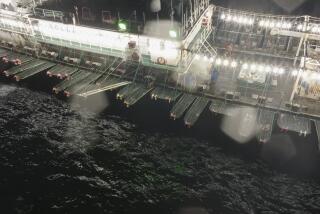Fast-Spreading Blight Cripples Mediterranean Spongers’ Livelihood
- Share via
KALYMNOS, Greece — The island of the fearless sponge divers now has an enemy it dreads: a fast-spreading blight that has chewed up sponge beds across the Mediterranean.
The disease, which leaves the few surviving sponges brittle and pockmarked, first appeared in the area in 1986 and returned late last year--threatening to kill an ancient trade that has been in decline for decades.
Imported natural sponges from the Bahamas or the United States are now sold next to the sand-colored local variety, saved from stock, at tourist shops on Kalymnos, near the Turkish coast about 180 miles southeast of Athens. The island’s few remaining sponge boats stay on the dock as crews wait for their luck to turn.
“There is total destruction [of sponges] across the Mediterranean,” said boat captain Manolis Saroukos, who is also the head of the island’s sponge fishing association. “People have lost their ability to make a living. I don’t know what will happen to them.”
On Saroukos’ summer expedition, his divers are more likely to bring back a modest catch of oysters than any healthy sponges.
Standing on the deck of his wooden boat, he holds up a sponge the size of a beach ball. It has a large crater on one side.
“This has been eaten away by the disease,” he complained.
So has the spongers’ livelihood.
Many spongers are still in debt from the last blight. And even when this one recedes, it will take several years for a new crop to form.
“The sponges were destroyed in exactly the same way both times. We are talking about a lot of damage,” said Eleni Voultsiadou, a biologist at Thessaloniki University in northern Greece.
Voultsiadou believes the blight may have been triggered by a rise in the seabed temperature, possibly caused by frequent earthquakes in the Aegean Sea area. Other scientists blame radiation from the 1986 Chernobyl nuclear disaster or fluctuations in bacteria levels.
Similar sponge kills broke out in the Gulf of Mexico in the 1940s, ‘70s and ‘90s, severely affecting Florida’s sponge industry.
“Even if the cause were known, there is nothing you could do. It’s not like treating crops on land,” said Nikos Papazoglou, a lawyer active in a number of Kalymnos’ community projects.
Sponges are primitive marine animals that often attach themselves to rocks. They use their porous outer layer to sieve food particles from the water. The chemical defenses used by the sponge are attracting growing interest from medical researchers, most importantly to try to develop new cancer-fighting drugs.
A small, quality, Greek sponge--harvested before the blight--sells for about $7, while imports go for slightly less.
Now more a novelty than a necessity, natural sponges were once the lifeblood and curse of barren Kalymnos.
The use of sponges is described in ancient Greek literature, and for centuries they were gathered the same way: by naked divers clutching flat slabs of rock and descending to depths exceeding 90 feet. The sponges plucked from the sea floor were placed in a rope basket around the diver’s neck.
A boom came about 100 years ago with the advent of the diving suit, which allowed divers to go deeper and stay down much longer. The sponge boats expanded beyond Kalymnos to off north Africa and around the Mediterranean.
Immigrants from Kalymnos and other islands made up a key part of the sponge trade in the United States, based mostly in Tarpon Springs, Fla.
But the divers, in their clumsy outfits and heavy brass helmets, sometimes perished and often faced the danger of improper decompression.
Thousands were killed and crippled over decades by the “bends” --when the nitrogen in air dissolves in body tissue.
“It causes the paralysis, dizziness and osteoporosis,” said Harilaos Biliris at Kalymnos’ marine museum. “Most of the divers over 50 showed signs of osteoporosis.”
One local dance, still performed at public gatherings, includes steps that mimic a crippled diver.
The children of Kalymnos’ divers and merchants who got the chance to study on the Greek mainland typically became doctors.
Ironically, when safer equipment became available in the 1960s, the sponge industry went further into decline.
Synthetic sponges and the loss of fishing rights in North Africa reduced Greece’s sponge fleet from hundreds of boats across the Aegean islands to just a handful on Kalymnos alone.
Annual output from Greek spongers went from about 4 million sponges in the 1970s to less than half that number in the following decade. Today the output is negligible.
Sponge merchants say ruthless competition between the rival businesses and reckless over-harvesting of Greek waters brought the industry to its knees even before the new blight appeared.
To make matters worse, fishermen also blame shortsighted policies by the European Union--promoting expansion in the 1980s and downsizing in the ‘90s--for the decades-long slump.
There is no talk, however, of abandoning the sponges completely.
“The people of Kalymnos love sponges even though they were the cause of the worst things that happened here, but they also once brought the island great prosperity,” said Biliris.
Kalymnos authorities have started three shallow-water sponge farms, while a few divers have worked off Libya, where some fields have been largely spared by the blight.
And the veteran Saroukos insists there will always be divers ready to come out of retirement if the blight ends and the industry rebounds.
“I know guys, crazy guys, who would stop at nothing and would dive as deep as they have to go to get a good sponge,” he said.
“They’ve started retraining programs,” he added with a laugh. “Fishermen were offered pottery lessons. I don’t think anybody went to the classes.”
More to Read
Sign up for Essential California
The most important California stories and recommendations in your inbox every morning.
You may occasionally receive promotional content from the Los Angeles Times.













